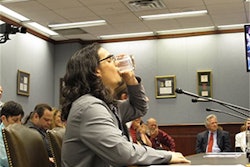When a company produces 150 tons of food waste every day, that is either a huge problem or a great opportunity to innovate and produce energy. New waste-to-energy technologies can transform this food waste into clean, green energy while also providing a bonus in reducing the amount of waste that goes into landfills. Grocery stores, restaurants, sports arenas, schools, and hospitals in the US generate an average of two tons — 4,000 pounds — of food waste per week. An estimated 35 million tons of food waste from commercial and residential sources end up in U.S. landfills each year, according to the U.S. Environmental Protection Agency.
Operators of commercial kitchens and other waste generators are increasingly looking for more environmentally sound ways to manage food waste than sending it to a landfill and with good reason: waste is expensive.
According to a Natural Resources Defense Council Issued Paper titled: Wasted: How America is Losing Up to 40 Percent of Its Food from Farm to Fork to Landfill (August 2012), author Dana Gunders noted that 40 percent of food in the United States today goes uneaten. Americans are throwing out the equivalent of $165 billion each year. Uneaten food ends up rotting in landfills as the single largest component of U.S. municipal solid waste, where it accounts for a large portion of U.S. methane emissions. At the processing level, the losses come mostly through trimming, when both edible (skin, fat, peels and end pieces) and inedible portions (bones, pits) are removed from food.
In-store food losses in the United States totaled an estimated 43 billion pounds in 2008, equivalent to 10 percent of the total food supply at the retail level. Most of the loss in retail is in perishables-baked goods, produce, meat, seafood and, increasingly, ready-made foods. The U.S. Department of Agriculture estimates that supermarkets lose $15 billion annually in unsold fruit and vegetables alone.
Kroger Model
Kroger Co., with 2,400 supermarkets in 31 states with most located throughout the Midwestern and Southern United States, faced their own challenges with waste and did something about it. In 2013, the company unveiled a clean energy production system that converts food that can't be sold or donated into clean energy to help power its Ralphs/Food 4 Less Compton, Calif., distribution center.
The newly installed anaerobic conversion system uses a naturally occurring process to transform unsold organics and onsite food-processing effluent into renewable biogas. This biogas is then turned into power for onsite operations. The process is carried out in an enclosed, oxygen-free environment, which means the process takes up less space and generates no odors. The system will provide enough renewable biogas to offset more than 20 percent of the energy demand of the Ralphs/Food 4 Less distribution center.
Kroger’s new system processes more than 55,000 tons of organic food waste into renewable energy annually and provides power for the more than 650,000-square-foot distribution center. By diverting that food waste — the equivalent of 150 tons per day — the system also will reduce area truck trips by more than 500,000 miles each year, according to the company. The Kroger Recovery System uses a sophisticated process to convert the carbon in organic material into a renewable source of methane.
Combining the use of renewable energy power with more than 150 zero emission fuel cell fork lifts, the Ralphs/Food4Less distribution center is now one of the greenest and most efficient, advancing the City of Compton as a leading sustainable community.
Kroger says its investment in the biogas digester will be paid back within five years, an 18.5 percent return on investment. It's considering adding biogas to other distribution sites.
Companies like Kroger discovered trucking food waste to distant landfills was costly, and decomposing organic waste in landfills can cause a host of environmental problems. Some U.S. states already have legislation in place that encourages the reduction of food waste sent to landfills and will effectively ban food waste from landfills over the next 10 years.
From Waste to Resource
The waste-to-energy (WTE) process starts when food is brought to the center and put through a blending system that removes any inorganic material — namely packaging, such as plastic, metal and glass — and liquefies the food. The organic material that is mixed with wastewater from the creamery is all the remains. That mixture goes into an anaerobic digester, an oxygen-free piece of equipment full of microbes that break the food down, producing biogas and a mix of nutrients and minerals. The biogas is then compressed and purified on its way to the campus' micro turbines and boilers, where it takes the place of nearly all of the natural gas that the center previously used. In the case of Kroger, their biogas now provides 20 percent of the campus' power and has delivered an 18 percent return on investment for the project so far.
Return on Investment
The use of WTE offers the following returns:
- Reuse of returns and dead stocks — with nearly 16 percent of raw materials lost during manufacturing, according to a WRAP UK study, WTE may help draw back returns on this loss.
- Reuse of both solid and liquid organic waste coming out of their production facilities.
- Reuse of the residual heat created by the combined heat and power (CHP) systems during the energy production process for internal needs, like steam, heat, cooling and hot water.
- Big brands that process animals can implement the same program in the farms raising animals, including chickens, pigs and cows, to eliminate the contamination created by the animal manure.
- The WTE plants can be installed and operated both onsite in the production or central logistic facility and save the transportation cost or in a separate facility.
- The projects can be implemented by the food companies or by companies such as Blue Sphere, which is ready to establish and operate these facilities on a Build, Own and Operate (BOO) basis.
Conclusion
New anaerobic digestion technologies make WTE an attractive financial and operational option for large food manufacturing companies. The savings that can be created, as well as the reduction in waste streams and resulting environmental benefits can set a new standard for best practices in the industry. Understanding the environmental benefits of efficient resource use and the financial benefits of significant cost savings results in an ultimate a win-win approach.
Mr. Shlomi Palas, CEO, is a clean-tech executive and entrepreneur with a large network in private and government sectors in North and South America, Europe, China and Africa. He leads, Blue Sphere Corporation (OTCQB: BLSP), an energy company that develops, manages and owns waste-to-energy projects in the $6 billion global waste-to-energy market.
Blue Sphere generates electricity from biogas derived from organic waste, which is mostly food waste, and sells this electricity to leading electric companies through long-term power purchase agreements. The Company has contracts with Caterpillar (NYSE:CAT) which is providing $17.8 million in non-dilutive project financing, and Duke Energy (NYSE:DUK) and National Grid (NYSE:NGG) which have both signed contracts to purchase electricity produced by Blue Sphere. The Company is building anaerobic digestion projects in the U.S which transform food waste into energy. There are only 202 of these anaerobic facilities in the entire U.S., as compared to 7,000 in Germany alone. Growth in the waste-to-energy market in the U.S. is driven by state and federal bans on putting organic waste into landfills and the need and demand for green renewable energy.
Mr. Palas holds a M.Sc. in Marketing from Baruch College - The City University of New York and a B.A. in Statistics and Management from Haifa University.
For more food industry news and information, subscribe here and follow us on Twitter, Facebook or LinkedIn.























